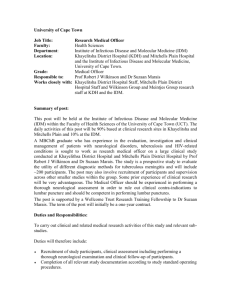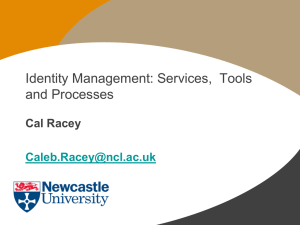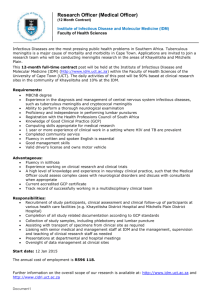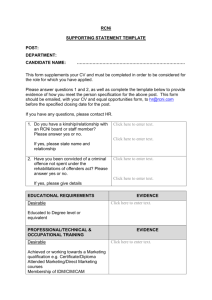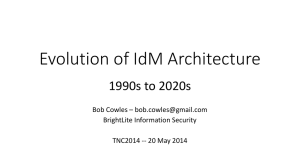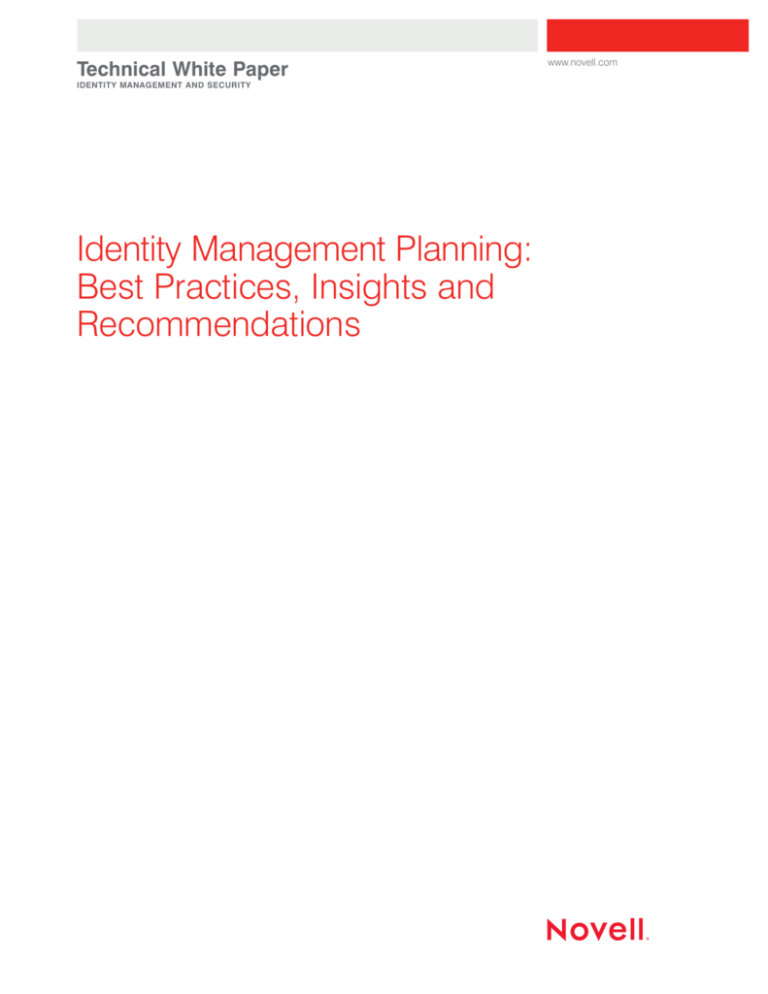
Technical White Paper
IDENTITY MANAGEMENT AND SECURITY
Identity Management Planning:
Best Practices, Insights and
Recommendations
www.novell.com
Identity Management Planning: Best Practices, Insights and Recommendations
Table of Contents:
2 . . . . . Why Identity Management
Best Practice Planning?
3 . . . . . Stages of Identity
Management (IDM) Maturity
4 . . . . . Categories of Identity
Management Best Practice
4. . . Best Practice 1: Identity Strategy
and Organizational Positioning
5. . . Best Practice 2: Future-state
Identity Services Architecture
Definition
7. . . Best Practice 3: Best-in-class
Identity Services Technologies
and Functionality
10 . . Best Practice 4: Business Benefit
Definition and Quantification
11 . . Best Practice 5: Identity Services
Initiative Roadmapping
12 . . Best Practice 6: Planning for
Implementation Competence
12 . . Best Practice 7: Identity Services
Governance
14 . . . . . Conclusion
p.
1
Why Identity Management
Best Practice Planning?
Best Practice
IDM Planning
The organizations that
are most successful with
identity management
are those that follow
“best practice” methods
and approaches in their
planning of identity
technology initiatives.
Given its complexity, breadth, implications
and importance, the phrase “don’t attempt
this at home” might well apply to identity
management deployment. But the truth is
most organizations today don’t have much
choice other than to proceed. The privacy,
security, compliance and business governance challenges that many organizations
face today make identity programs essential.
Add to this the potential to create business
value by improving efficiencies and automating business processes, and there is
more than ample justification for investing
in identity management (IDM).
As the famous philosopher, Yogi Berra,
once said, “When you come to a fork in the
road, take it.” There are many forks in the
road along the path to an identity management solution, represented by a host of
decisions that must be made in order to
deploy successfully as well as to gain the
available business benefits.
Authored by:
John H. Dobbs
Principal Strategist
Novell Worldwide Services
The limited length of this paper does not
permit discussion of the many possible
areas of identity management best practice.
Instead we will attempt to create awareness
of the IDM best practice planning areas that
we consider essential. In the process, we will
describe how these planning factors can
account for differences between leading
and below average identity programs.
Where practical, we will illustrate some of
these factors with examples, criteria and
suggested approaches. Our goal is simply
p.
2
to inform decision-makers and sponsors of
enterprise-grade identity management (or for
short, IDM) programs about the benefits of
best practice identity management planning
and increase awareness of the associated
(and unfortunately not-so-obvious) pitfalls
of failing to do so.
Our experience (formed while working with
literally hundreds of IDM clients) reveals that
the organizations that are most successful
with identity management are those that follow
“best practice” methods and approaches
in their planning of identity technology initiatives. Best practice is easily aspired to, but is
fairly difficult to accomplish—for a variety of
reasons. Two key reasons are: first, identity
management touches so many parts of the
organization, within IT and beyond; and,
second, IDM must integrate with diverse
areas and components of the technical
infrastructure. These two realities can make it
difficult to create the support and degree of
consensus required for a successful identity
management program. These two issues
aside, there are many other challenges that
necessitate best practice planning.
A working definition of identity management
“best practice” may be helpful at this point:
“Methods, approaches and capabilities that
are leading edge and/or that maximize the
probability of successful identity and security
management program implementation and
business benefit capture.”
Identity Management Planning: Best Practices, Insights and Recommendations
www.novell.com
Stages of Identity Management
(IDM) Maturity
It is primarily during
the enhanced and
advanced maturity stages
of IDM deployment that
organizations will realize
the significant ROI that
can come from identity
technologies.
Although best practice identity management
is a desirable goal, it is a status that can
realistically be achieved only in stages.
That is, the level of IDM “maturity” at which
the organization finds itself in essence determines the degree of best practice that can
be expected and experienced at that stage
of program maturity. For example, an organization just beginning to deploy an IDM
infrastructure will not and cannot have the
IDM capabilities of an organization that
has achieved a more advanced degree of
IDM maturity. That being said, using best
practice approaches and technology early
on greatly affects an organization’s ability
to achieve best practice capabilities in subsequent stages of maturity. The “Identity
Services Maturity Continuum” shown below
illustrates typical enterprise capabilities
by stage.
Stages of Identity Management Maturity
At the beginning of 2008 we estimate that most organizations (50 percent or so) are still in the
basic-foundational stages of IDM deployment, while only 30 percent are in the enhanced or
advanced stages. Some have yet to begin in any serious way with a real program. This is a
meaningful observation because it is primarily during the enhanced and advanced maturity
stages of IDM deployment that organizations will realize the significant ROI that can come
from identity technologies. So the challenge is to move adroitly from basic to enhanced, and
then to advanced maturity stages. While that may seem logical, in practice moving from one
stage to the next can be daunting. Our experience has shown that a reliable predictor of such
progress is the observability of multiple best practice techniques and approaches during both
planning and deployment of IDM capabilities.
p.
3
An “Identity Services”
strategy considers many
ways the business will
leverage and benefit from
its IDM infrastructure,
including physical
security, logical security,
asset accountability,
compliance, risk
mitigation, partner
enablement and so on.
Categories of Identity
Management Best Practice
Our experience with IDM initiatives has
revealed seven basic categories of best
practice planning to be aware of throughout
all stages of program maturity:
1.
2.
3.
4.
5.
6.
7.
Identity strategy and organizational
positioning
Future-state “identity services” architecture
definition
Best-in-class identity services technologies
and functionality
Business benefit definition and
quantification
Identity services initiative roadmapping
Planning for implementation competence
Identity services governance
Each of these categories can by itself make
a difference in the quality and success of an
IDM deployment. But taken together, achieving best practice in all of these seven areas
has tremendous potential to impact the
outcome of any IDM program.
Best Practice 1: Identity Strategy
and Organizational Positioning
Identity management initiatives frequently
suffer from a lack of broad organizational
understanding and support. The reasons
for this typically include one or more of
the following:
Lack of education about identity-related
technologies and capabilities
Poor understanding of program benefits
Point solutions being pursued (rather than
enterprise enablement)
IT sponsorship vs. business sponsorship
Lack of realistic business case to justify
investments; lack of budget
p.
4
Reluctance of some system/data owners
Slow deployment; failure to show rapid
value or benefit capture
Technical complexity and IDM software
product issues
Divided opinions about technology/
vendor selection
A key issue is often that an enterprise-wide
executive level understanding of how identity
management will add value to the business
does not exist. Frequently, IT or IT security
functions begin deploying limited IDM capabilities that benefit their functions, such as
user directory integration or automated
account creation, but that do not necessarily
benefit the business as a whole. Another
example is when the finance/audit department
wants the capability to monitor access,
but few if any other areas of the business
will benefit.
These are hard problems that most organizations we’ve worked with have had to
address. What works is a well-defined identity strategy that takes these problems into
account ahead of time. It’s also useful to
always keep the “big picture” of benefits and
capabilities in view; that way the inevitable
challenges that arise are kept in context.
Rather than focusing on just one or two
favored point solutions, it’s best to define a
more comprehensive, enterprise-level identity
services program and strategy. An identity
services strategy recognizes and plans for
a full range of identity capabilities that will
drive benefits across multiple areas of the
business, thus creating support for an
initiative that can be positioned in a more
strategic, value-producing way.
www.novell.com
Identity Management Planning: Best Practices, Insights and Recommendations
Identity Services—A Best Practice Enterprise-level Value Proposition for IDM
An identity services strategy considers many
ways the business will leverage and benefit
from its IDM infrastructure, including physical
security, logical security, asset accountability,
compliance, risk mitigation, partner enablement and so on. Because of this broader
range of potential capabilities and benefits,
a certain amount of internal education is
usually necessary to help key stakeholders
understand how foundational an identity
management infrastructure can be to the
business. In fact, an identity management
foundation is fundamental to support and
enable security, and to risk management,
compliance and governance programs of all
types. As an understanding of these critical
capabilities develops, broader support for
identity management also occurs.
And, even if budgets are small, or the
organization wants to proceed cautiously with
identity management, defining enterpriselevel value and strategies up front is highly
beneficial to avoid stalling out as the IDM
initiative progresses.
Best Practice 2: Future-state Identity
Services Architecture Definition
Many organizations have embarked on
identity management initiatives and projects
without understanding the implications for
their larger enterprise infrastructure and
architecture. This is especially common in
organizations where limited function or point
solutions are deployed. Repercussions of
“deploying without architecting” include the
potential for implementing technologies that
are not standards based (and therefore do
not integrate properly with future infrastructure elements), or selecting technologies that
will not interoperate with all required existing
systems successfully.
Best practice, on the other hand, means
defining and documenting both a shortterm and a longer-term, future-state identity
p.
5
A best practice, futurestate identity services
architecture generally
conforms to multiple
desired architectural
characteristics:
architecture for the enterprise. This proactively
created future architecture should be identity
services comprehensive, incorporating but
not necessarily limited to the following:
HR systems
Service directories
Metadirectory, or identity vault
Access management system
Identity management provisioning system
E-mail system
File and print services
Network; intranet
Remote access
Telephone system
Mainframes
Badge system for physical facilities access
Databases
Helpdesk system
ERP systems
Document management system
Roles management system
Portals, and so on…
Service oriented
Standards based
Flexible and
interoperable
Loosely coupled
Secure
Appropriately
redundant
Scalable
Efficient
The future-state architecture should define
how the identity services infrastructure will
integrate with each of these systems as well
as any other systems that will be authoritative
for identity attributes. The architecture will
define how the various systems will synchronize, protect and audit identity data.
A best practice, future-state identity services
architecture generally conforms to multiple
desired architectural characteristics, including:
Service oriented
Standards based
Flexible and interoperable
Loosely coupled
Secure
Appropriately redundant
Scalable
Efficient
p.
6
A best practice identity services architecture
is designed in such a way as to accommodate immediate needs and enable short-term
identity and security functionality requirements.
But its design must also anticipate and provide for future capabilities (both known and
unknown) as well as acknowledge the need
for growth and scalability over time. Among
the identity-related capabilities to be enabled
by the architecture are:
Centralized identity store or metadirectory
Identity data synchronization
Reduced or single sign-on
Distributed ownership of identity data
and permissions
Automated provisioning
Roles-based provisioning
Workflow-based provisioning
Integrated physical and logical access
control
Policy-based roles management
Identity federation
Compliance monitoring and reporting
Zero-day start; zero-day stop
Among architectural best practices, key
(and frequently overlooked) is the design
and deployment of a centralized “identity
vault” that functions as the hub of a wellplanned “hub and spoke” directory architecture. The identity vault is the “central nervous
system” or metadirectory that synchronizes
and manages identity attributes from other
authoritative, trusted sources and shares
them with other consuming directories and
applications. This is the foundational element
of an identity services infrastructure. In its
absence, deploying advanced identityrelated capabilities becomes problematic.
A best practice identity architecture is
“service-oriented,” meaning that identity
capabilities such as those mentioned
www.novell.com
Identity Management Planning: Best Practices, Insights and Recommendations
previously are available to the enterprise as
a service that is accessible to a variety of
applications, systems and user constituencies.
It is this service orientation that accounts for
many of the business efficiencies that can be
accomplished by a well-designed identity
services infrastructure.
In our experience, best-in-class technologies
or products will exhibit several or preferably
all of these characteristics:
1.
2.
Unique or superior functionality when
compared with other products
Ease or simplicity of integration; less need
for customization
High levels of interoperability with other
solution components and/or connected
systems
Ability to scale to meet future needs or
requirements, known or unknown
Low cost of ongoing use
For some organizations, deploying a serviceoriented identity services architecture is a
logical step toward SOA (service oriented
architectures) in general, because the identity
architecture can be a good example of how
SOA should work.
3.
Best Practice 3: Best-in-class
Identity Services Technologies
and Functionality
These criteria should be considered when
choosing between commercially available
software or when having custom or internally
developed technologies designed.
Best-in-class technologies are in and of
themselves best practice when it comes to
designing identity management solutions.
IT departments often start down the path of
IDM deployment using the technologies they
are most familiar with only to realize later that
the products selected are not capable of the
functionality that is needed in subsequent
phases. Or they find that the products
selected initially do not integrate well with
other systems or won’t scale as required.
These organizations then “hit the wall” and
stall in their effort to move from the basic
to more advanced stages of IDM maturity
where more visible benefits and ROI occur.
This problem can be averted by choosing
best-in-class technologies.
When scanning for best-in-class IDM technology components, Gartner’s “Leaders Quadrant” evaluations are a good place to begin
identification of potentially useful identity and
security-related technologies. But the Gartner
criteria of “ability to execute” and “completeness of vision” are a bit too high level to
compare against specific business needs.
4.
5.
In a best practice identity services infrastructure, the full range of needed identity infrastructure components should be evaluated
by applying the best-in-class technology
characteristics cited previously. Components
to consider include:
Metadirectory
Log-in management
Access management
Identity management and provisioning
Roles management
Logging, auditing, reporting (compliance)
To provide an illustration of a technology
comparison analysis, the metadirectory component is used as an example for comparing
multiple directory products. In our example,
specific product/technology characteristics
and capabilities are judged to be either:
Best in Class (or advanced)
At Parity—with capabilities exhibited by
products in this category
3. Lagging—compared with capabilities
exhibited by products in this category
1.
2.
p.
7
Metadirectories: Key Functionality/Capability Analysis
This type of analysis can be done for the
characteristics of each component of the
practice infrastructure. Of course, IDM functionality requirements vary from one organization to another. For example, federation of
partner or other external identities from a
trusted source may be critical to some
organizations, but not others. Likewise, if
future plans and needs do not include managing and storing identities of large numbers
of customers or physical assets, scalability
may not be as important.
Another factor to consider when selecting
technology is that some vendors have
assembled their IDM technology components from acquisitions rather than developing them internally. This means that although
p.
8
the various components may perform well
separately, when integrated together they
either do not perform well, are costly to integrate or both.
When analyzing technologies, role-based
access control as well as audit/compliance
technologies merit special mention because
so few organizations have achieved mature
capability in these areas.
Role-Based Access Control Capability
In organizations that are more advanced
with identity programs, there is rapidly
increasing interest in role-based access
control (RBAC). RBAC is an approach to
policy-driven user provisioning and access
control. It is important because it improves
www.novell.com
Identity Management Planning: Best Practices, Insights and Recommendations
security and compliance, while at the same
time reducing IT administration costs.
access and permissions manually at only
the departmental or application level.
RBAC capability is becoming more common
within application suites. Major application
vendors such as SAP and Oracle are already
using RBAC to manage user access rights
within the scope of their applications. However, the real enterprise transforming potential
of RBAC is its ability to manage access rights,
or permissions, across many applications.
The same RBAC process that controls access
to the corporate network can also manage
the provisioning of cell phones or building
access cards. RBAC offers greater business
benefit as an enterprise-wide identity service
than as an application-specific one.
Integrated IDM and Security Information
and Event Management Systems
Best practice RBAC initiatives include the
analysis and definition of roles from both a
top-down (enterprise level) and a bottom-up
(user group) perspective. Why? Because
existing organization roles may be at too high
a level or be too poorly defined to function
properly in an RBAC environment. The goal
is to define the minimal, simplest set of roles
that will correctly provision users with all the
access rights they require and are authorized
to have, but no more. Best practice methodology will create neither too few nor too many
roles. Some organizations have ended up
with more roles than they have jobs!
Best practice RBAC also requires meaningful
coordination between stakeholders—IT,
security, compliance, application owners
and business managers. A recent study
by Ponemon Institute shows that these
groups rarely coordinate. In fact, 86 percent
of organizations surveyed still audit user
In today’s enterprise there is an inordinate
emphasis on compliance with government
regulations (such as PCI, HIPAA, SOX,
GLBA, FISMA and so on), not to mention
the numerous governance requirements
imposed internally. In most organizations
the technologies that enable compliancerelated tasks and activities such as monitoring, logging and reporting of security events
operate completely separately from the
identity management infrastructure.
In a best practice identity environment, the
identity and security systems are integrated
to enable a more robust set of compliance
capabilities. These capabilities are able to
reliably detect and take action on issues
such as:
Separation of duties violations
Unauthorized system administrator activity
User provisioning violations
Critical file access violations
Exploit detection
Real-time attack detection
Unauthorized access
Business policy violations, and so on
In best practice environments, organizations
can leverage their RBAC and integrated
security monitoring capabilities (based on
policy) to detect, report and remediate separation of duties issues as well as a wide
range of other security risks and violations.
p.
9
Best Practice 4: Business Benefit
Definition and Quantification
A frequent barrier to adoption of identity
management within organizations is the
absence of a clear business case that
defines and quantifies the financial benefits of
identity initiatives in a format that is meaningful and persuasive to key executives. In the
absence of clear financial data, executives
tend to view IDM initiatives strictly as a
cost issue, rather than as an ROI-producing
activity. For this reason, best practice IDM
planning includes development of an organization-specific business case that considers
all relevant costs and benefits associated
with the initiative.
A thorough business benefit analysis for
IDM focuses not just on benefits that accrue
to the IT and security functions, but also
identifies benefits that are achievable within
business operating units. This means that
business initiatives that could potentially
benefit from identity services enablement
should be investigated to determine the
financial value of such enablement.
For example, in a large benefits management
company, the identity services solution is
being used to dramatically shorten the time
required to reassign and reprovision client
data access for customer service personnel.
At the same time it is also validating the
security clearance of these representatives
so as not to violate client confidentiality commitments. This secure, automated access
provisioning capability has delivered considerable financial benefit to the business unit.
Of course, not all business benefits are
quantifiable, so it is also reasonable and
appropriate to include such benefits as user
satisfaction or time savings in the analysis,
even if they are not quantifiable. Security and
risk mitigation benefits can also be difficult
to quantify. The analysis can be segmented
into quantifiable and nonquantifiable benefits,
p.
10
but it is the quantifiable side that most interests business sponsors. These quantifiable
benefits typically include reduced manual
administrative burdens, increased speed to
productivity for employees being provisioned
with access rights, decreased licensing
costs as unnecessary users are deprovisioned, reduced application development
costs due to reusable security and access
controls, and cost avoidance from better
management of assets such as computers,
cell phones and so on.
A well-implemented identity services initiative
is capable of delivering meaningful benefits
in a combination of ways, such as:
Cost avoidance (reducing planned
future expenditures)
Cost reduction (reducing existing costs)
Time, productivity and process
improvements
User convenience and satisfaction and
complaint reduction
Sales and revenue improvement
(customer facing initiatives)
Security and compliance enhancement
The key is to understand which benefits in
each of these categories apply to specific
user groups, functions or business units
across the enterprise. Then you can calculate the magnitude of the financial benefit
over time.
An analysis of the business value generated
across multiple organizations implementing
identity services showed a three-year net present value (NPV) of US$1,349 per employee.
IDC estimates an average annual savings
of US$60,210 per 100 users from deploying
identity and security management solutions.
It should be acknowledged that the financial
benefit of identity services initiatives can vary
widely, depending on an organization’s size,
existing technical environment, program
www.novell.com
Identity Management Planning: Best Practices, Insights and Recommendations
objectives and so on. This is another reason
for validating your organization’s specific
business case for identity management.
Best Practice 5: Identity Services
Initiative Roadmapping
There are typically multiple identity initiatives
or projects that need to be implemented
once an overall identity strategy has been
defined and the business benefits have
been established. Experience has shown that
there is normally uncertainty (or even internal
competition) about the priorities of these
initiatives. For example, should technical
considerations or business needs drive
implementation sequencing?
Best practice for these decisions is represented by an identity services “deployment
roadmap.” Considering business need,
business value, technical dependencies and
prerequisites, resource availability, budgets
and other factors, an implementation road-
map should be developed that defines the
preferred, optimal and agreed upon path
forward for identity program implementation.
The identity services roadmap becomes the
agreed plan for implementing the future-state
identity architecture over time as outlined
previously in this white paper.
The roadmap is typically laid out for an 18–24
month period. Once finalized, it serves as
the guidepost against which more detailed
planning can be done and implementation
progress can be monitored. Because identity
programs touch so many of the organization’s
systems, the roadmap becomes a valuable
planning and communications tool for all
those involved, as well as a coordination
mechanism for avoiding duplication of effort
and overlapping technologies.
While deployment roadmaps look quite
different from one organization to another,
this example is typical for an early stage
implementation.
Identity Services Roadmap—Example
p.
11
The roadmap illustrates the need for a
phased implementation that is orchestrated in
order to optimize both resources and results.
Best practice means that the roadmap is
revisited and updated every six to 12 months
in order to keep the deployment plan up-todate and aligned with actual events and
program progress.
Best Practice 6: Planning for
Implementation Competence
Although thoughtful planning and roadmapping are key predictors of success, they
don’t guarantee successful implementation.
The breadth and depth of coordination
required to successfully implement IDM
capabilities demands strong program
management skills and tools. Typically,
IDM implementations are characterized by
multiple tracks or projects being underway
simultaneously, with numerous interdependencies. This requires implementation oversight and coordination beyond management
of discrete projects. Organizations need to
view IDM implementations as a program
with the necessary levels of visibility and
authority to span multiple projects.
Competent implementation means that the
individuals responsible for deploying IDM
capabilities are appropriately skilled in their
new roles and technologies. This may require
that skills assessments and corresponding
training plans be in place early, well before
any advanced identity services capabilities
are scheduled to go live. Implementation
p.
12
competence also means addressing business process change and technology change
in parallel, not as separate issues.
Best Practice 7: Identity Services
Governance
The very same issues that make identity
initiatives difficult to advance in organizations
(for example, many organizational areas
being affected and involved; a large number
of systems to integrate) make it necessary to
provide governance to guide the overall program, ensuring that it is properly sponsored
and managed. At its most basic, governance
means creating the structure, processes and
policies required to keep the initiative in line
with the organization’s expectations and
plans. Governance provides appropriate
oversight, ensuring steady, coordinated
progress. It will also provide a mechanism
for cross-functional involvement and decision
making. What takes governance beyond the
realm of traditional program management
is its ongoing nature and its focus on continuous improvement.
At a practical level, there are varied
constituencies (as well as risks) that need to
be considered as part of an identity services
governance plan. Best practice identity
governance is a priority from the beginning
and is ongoing. Governance must focus on
both the business and technology domains
of the identity equation. Representative
issues and topics are illustrated in the
following illustration:
www.novell.com
Identity Management Planning: Best Practices, Insights and Recommendations
Identity Services Governance
A best practice starting point for good IDM
governance involves articulation and communication of guiding principles for enterprise
identity programs. Among other things, these
principles convey the necessity for consistency
and standards—they suggest important do’s
and don’ts. Examples of a few selected
guiding principles from actual companies
are illustrated here:
Guiding Principles for
Enterprise Identity Services
In our business, the identity management
system manages the identities of multiple
“entities” including humans, computers,
mobile devices, network elements,
applications, and other physical and
intellectual assets.
Every entity shall have a unique identifier
that does not change over time.
A well defined, single, logical identity
repository shall contain the “gold copy” of
all identity information that is in turn updated
solely by trusted, authoritative sources.
The business processes that create or
change the status of an entity result in the
automatic updating and synchronization
of identity information.
All internally developed and externally
sourced applications will be LDAPcompliant and leverage the shared
enterprise identity infrastructure, rather
than relying on application-specific
authentication methods.
The identity infrastructure provides
meaningful reports on auditable identity
events as required for compliance purposes.
The identity management infrastructure is
sufficiently flexible and interoperable to
support a heterogeneous environment.
The identity solution is loosely coupled,
ensuring no single point of failure.
The identity infrastructure is based on
service oriented architecture principles.
p.
13
The best, most effective identity management programs will be those
that benefit from best practice planning approaches.
www.novell.com
Conclusion
Identity services deployment is a challenging
journey for any organization, but it is a journey made considerably less risky and with
eminently more impact when undertaken in
a well-orchestrated manner. Our experience
convinces us that shortcutting the IDM planning disciplines described here frequently
results in less than desired rates of progress
toward the more advanced stages of program maturity and resulting ROI.
We assert with considerable confidence that
the best, most effective identity management programs will be those that benefit
from best practice planning approaches.
Contact your local Novell®
Solutions Provider, or call
Novell at:
1 800 714 3400 U.S./Canada
1 801 861 1349 Worldwide
1 801 861 8473 Facsimile
Novell, Inc.
404 Wyman Street
Waltham, MA 02451 USA
462-002078-001 | 03/08 | © 2008 Novell, Inc. All rights reserved. Novell, the Novell logo and the N logo are registered trademarks of
Novell, Inc. in the United States and other countries.
*All third-party trademarks are the property of their respective owners.





